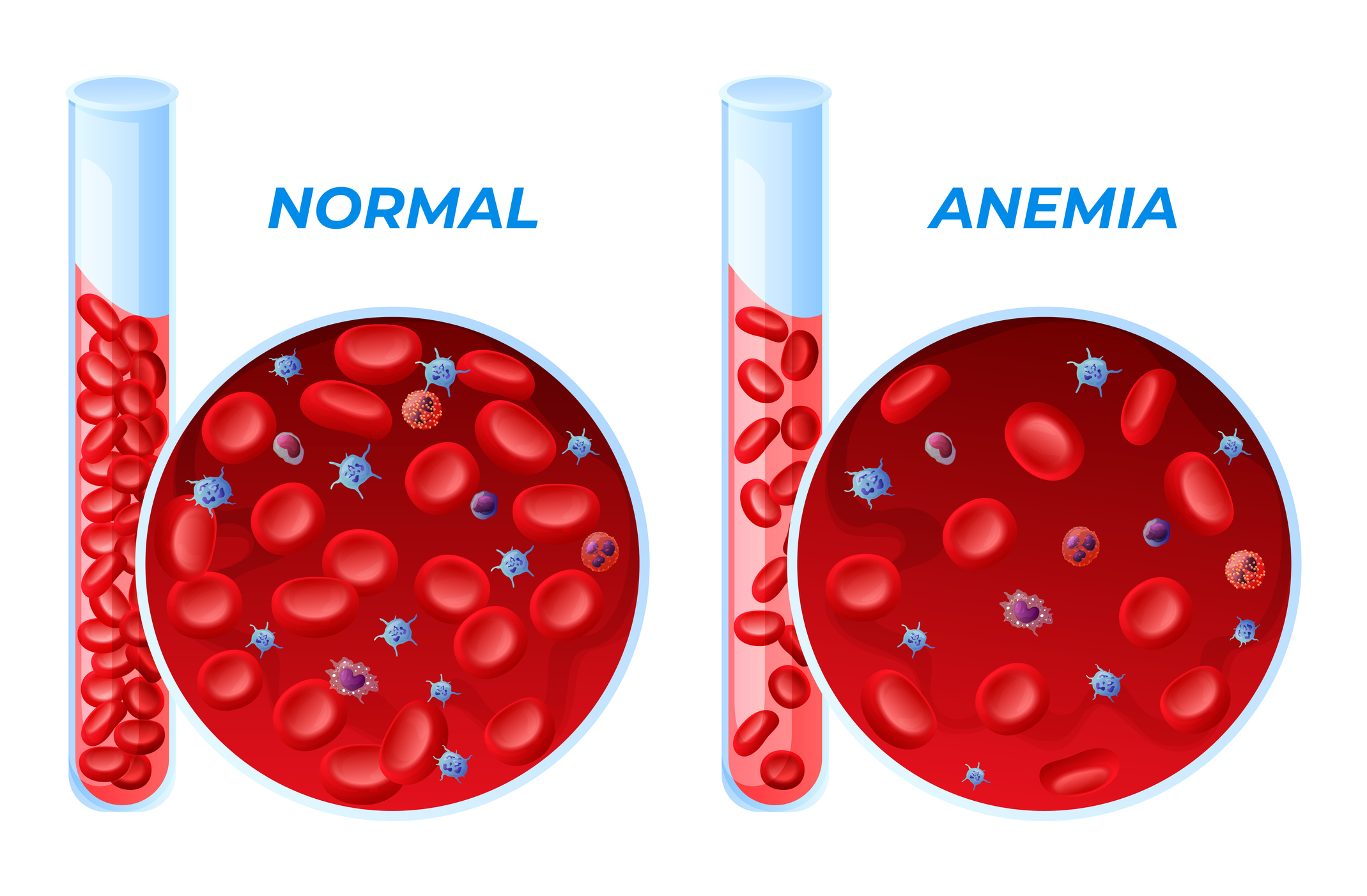
Anemia is a condition caused by an insufficient number of red blood cells or their inability to effectively carry oxygen to the body's tissues. Red blood cells are essential to a healthy body because they carry oxygen from the lungs to all tissues and cells in the body. At the same time, red blood cells remove carbon dioxide, a byproduct of the respiratory process, from tissues and cells, transporting it back to the lungs, where it is released into the environment.
Types
There are different types of anemia, which differ in the cause of the lack or ineffectiveness of red blood cells.
Iron deficiency anemia: This is the most common type of anemia. It occurs when our body does not get enough iron to make hemoglobin, the protein found in red blood cells that carries oxygen. Possible causes of iron deficiency include inadequate dietary iron intake, excessive iron loss from bleeding, or age-related iron malabsorption.
Vitamin B12 deficiency anemia (pernicious anemia): This condition occurs when the body does not get enough vitamin B12, which is essential for the formation and growth of red blood cells. This is most commonly due to age-related malabsorption of vitamin B12, but can also be associated with a vegetarian diet that lacks sources of vitamin B12.
Aplastic anemia: This is a rare but very serious condition in which the bone marrow cannot produce enough red blood cells. It can be caused by infections, autoimmune diseases, exposure to radiation or chemotherapy, or genetic disorders.
Hemolytic anemia: This condition occurs when red blood cells are destroyed too early or too quickly. It can be associated with congenital disorders such as spherocytosis, or it can be caused by the immune system attacking and destroying red blood cells.
What causes anemia?
There are various factors and causes that can cause anemia, and they depend on the specific form of anemia.
Iron deficiency: This is one of the most common causes of anemia. Iron is needed for the production of red blood cells and its deficiency can cause anemia. Iron deficiency is usually caused by insufficient dietary intake, excessive bleeding where iron is lost through the blood, or age-related malabsorption.
Vitamin B12 and folic acid deficiency: These two nutrients are essential for the production of red blood cells. Their deficiency can cause anemia, which can be related to insufficient nutrition, certain diseases of the digestive tract that interfere with the absorption of these nutrients, or an unbalanced diet.
Blood loss: Excessive blood loss from trauma, surgery, digestive disorders, menstruation, or other causes can cause anemia.
Bone marrow disorders: Bone marrow is responsible for producing red blood cells. Any disorder, such as cancer, radiation, chemotherapy, or genetic disorders, that affects the bone marrow's ability to produce red blood cells can cause anemia.
Disease or disorder that destroys red blood cells: Some diseases or disorders, such as autoimmune diseases, infections, certain drugs, toxins, and some genetic disorders, can destroy red blood cells faster than the body can produce them, causing anemia.

Anemia symptoms
Although anemia may be almost invisible in the early stages, as the condition progresses, the following symptoms may appear:
Weakness and fatigue: This is one of the most common symptoms of anemia. Because the body's tissues are deprived of oxygen, they cannot function as efficiently as they should, causing a person to feel constantly tired or weak.
Pale skin: A lack of oxygen can cause the skin to change color, making it look paler or lighter than normal. Others may notice that the skin turns yellow.
Tachycardia (increased heart rate): When the body is not getting enough oxygen, the heart may start beating faster in an attempt to pump more blood and oxygen to the body's tissues. This can cause a feeling of your heart beating faster or an increased heart rate.
Difficulty breathing: Lack of oxygen can cause shortness of breath or difficulty breathing, especially during exercise.
Dizziness or headache: When the brain is deprived of oxygen, dizziness, headache or even blurred vision can occur.
Cold hands and feet: Circulatory disorders can cause a cold sensation in the hands and feet.
It is important to note that the symptoms of anemia can vary depending on the type of anemia and its severity. In addition, some people may experience other symptoms not mentioned in this list. Therefore, it is recommended to consult a doctor in case of any unexplained or prolonged fatigue, weakness or other unusual symptoms.
How is anemia treated?
Treatment for anemia, or anemia, depends on the type and cause, and may include medications, dietary changes, and other medical procedures. Here are some common strategies for treating anemia:
Iron Supplements: In the case of iron deficiency anemia, treatment usually involves the use of iron supplements. Iron helps the body produce more red blood cells. It is important to take iron supplements as directed by your doctor, as too much iron can cause side effects such as constipation.
Vitamin B12 and folic acid supplements: In cases of vitamin B12 and folic acid deficiency anemia, treatment may include taking these vitamin supplements. These vitamins help the body produce more red blood cells
Hormone therapy or medications: Some people with certain forms of anemia may be prescribed medications that help the body make more red blood cells.
Blood transfusion: Severe anemia may require a blood transfusion. This is a procedure in which a person is given a transfusion of donor blood to increase the number of red blood cells.
Bone marrow transplant: In rare cases where anemia is associated with serious bone marrow disorders, a bone marrow transplant may be recommended. It is a complex and risky procedure in which the damaged bone marrow is replaced with healthy bone marrow from a donor.
What are the consequences of anemia?
Anemia can cause many health problems and disorders. Its consequences depend on the severity and duration of anemia, but they may include:
Fatigue and weakness: These are some of the most common symptoms of anemia. The reduced amount of oxygen in the body's tissues can cause people to feel constantly tired and weak, even if they get a lot of sleep.
Weakened immunity: Iron is important for the functioning of the immune system. Thus, anemia can reduce the body's resistance to infections and diseases.
Circulatory disorders: Severe anemia can cause cardiovascular disorders such as tachycardia (fast heart rate) or heart failure. This happens when the heart has to work harder to pump more blood and deliver enough oxygen to the tissues.
CNS disorders: Anemia can affect the functioning of the nervous system, leading to disorders such as headaches, mood swings, difficulty concentrating, and memory problems.
Developmental disorders in childhood: Children and adolescents who lack sufficient iron may have developmental and learning problems.
Complications during pregnancy: Anemia during pregnancy can increase the risk of complications such as premature birth and low birth weight. In addition, it can increase the risk of maternal death during childbirth.

Prevention of anemia
Prevention and control are key factors in preventing anemia. The earlier action is taken, the lower the chance of developing anemia and the better the condition can be managed. Here are some steps you can follow:
Balanced diet: A diet that contains enough iron, vitamin B12, and folic acid can help maintain healthy red blood cell levels. Iron-rich foods include meat, legumes, grains, nuts, and sunflower seeds. Sources of vitamin B12 include meat, dairy products, and eggs, while sources of folic acid include vegetables, fruits, and grains.
Iron supplements: Women who are menstruating, pregnant or breastfeeding, as well as children and adolescents may be advised to take iron supplements to maintain adequate red blood cell levels.
Donating blood: If you are a regular blood donor, it is important to check your hemoglobin level regularly to prevent anemia. Blood banks usually do this test before they let you donate blood.
Treatment for diseases that cause anemia: Some diseases, such as lung, kidney or liver diseases, as well as certain infections, can cause anemia. Proper treatment of these diseases can help prevent anemia.
Stop smoking and limit alcohol consumption: Smoking and excessive alcohol consumption can increase the risk of anemia because they can affect the production and function of red blood cells.
These tips are general recommendations, so it's important to consult with your doctor who can develop an individual prevention plan based on your health and lifestyle.
Foods containing iron
Iron is an essential mineral that is important for body functions, including the production of red blood cells. Here is a list of foods that are high in iron:
Meat and Poultry: Meat and poultry are excellent sources of iron. Beef, pork, veal, chicken and turkey are especially rich in iron. Iron from meat (heme iron) is more easily absorbed than iron from plant sources (non-heme iron).
Fish and seafood: Fish such as salmon, tuna, and sardines, as well as seafood such as shrimp and clams, are good sources of iron.
Legumes: Beans, lentils, peas and soy products are rich in non-heme iron, which is important for vegetarians and vegans.
Grains: Several grains, especially whole grains such as wheat, oats, and buckwheat, are good sources of iron. In addition, many cereal products such as bread and breakfast cereals are fortified with iron in many countries.
Vegetables: Certain vegetables such as spinach, broccoli and red peppers are also good sources of iron.
Nuts and seeds: Nuts such as almonds and cashews and seeds such as flaxseeds and sunflower seeds are also rich in iron.
Dried fruits: Dried fruits such as raisins, apricots and figs are another good source of iron.
It is important to remember that the body absorbs iron more easily from animal products than from plant products. Taking vitamin C together with non-heme iron can help improve its absorption. If you have questions about your diet, consult a dietitian or other health care professional.

Sources of information:
World Health Organization. Haemoglobin concentrations for the diagnosis of anemia and assessment of severity. Vitamin and Mineral Nutrition Information System. Geneva, 2011 (WHO/NMH/NHD/MNM/11.1) [http://www.who.int/vmnis/indicators/haemoglobin.pdf]
Lopez A, Cacoub P, Macdougall IC, Peyrin-Biroulet L. Iron deficiency anemia. Lancet. 2016 Feb 27;387(10021):907-16.
Briani C, Dalla Torre C, Citton V, Manara R, Pompanin S, Binotto G, Adami F. Cobalamin deficiency: clinical picture and radiological findings. Nutrients. 2013 Nov 15;5(11):4521-39.
Young NS, Kaufman DW. The epidemiology of acquired aplastic anemia. Haematologica. 2008 Apr;93(4):489-92.
Gehrs BC, Friedberg RC. Autoimmune hemolytic anemia. Am J Hematol. 2002 Mar;69(3):258-71.
Nissenson AR, Goodnough LT, Dubois RW. Anemia: not just an innocent bystander? Arch Intern Med. 2003 Jul 14;163(13):1400-4.
Schrier SL, Schrier SL. Approach to the adult patient with anemia. UpToDate, Waltham, MA: UpToDate Inc. https://www.uptodate.com.
Camaschella C. Iron-deficiency anemia. N Engl J Med. 2015 May 7;372(19):1832-43.
# mažakraujystė # anemija # geležies trūkumas
